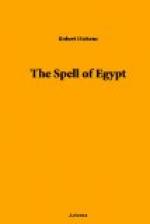X
MEDINET-ABU
At the entrance to the temple of Medinet-Abu, near the small groups of palms and the few brown houses, often have I turned and looked back across the plain before entering through the first beautiful doorway, to see the patient backs and right sides of the Colossi, the far-off, dreamy mountains beyond Karnak and the Nile. And again, when I have entered and walked a little distance, I have looked back at the almost magical picture framed in the doorway; at the bottom of the picture a layer of brown earth, then a strip of sharp green—the cultivated ground—then a blur of pale yellow, then a darkness of trees, and just the hint of a hill far, very far away. And always, in looking, I have thought of the “Sposalizio” of Raphael in the Brera at Milan, of the tiny dream of blue country framed by the temple doorway beyond the Virgin and Saint Joseph. The doorways of the temples of Egypt are very noble, and nowhere have I been more struck by their nobility than in Medinet-Abu. Set in huge walls of massive masonry, which rise slightly above them on each side, with a projecting cornice, in their simplicity they look extraordinarily classical, in their sobriety mysterious, and in their great solidity quite wonderfully elegant. And they always suggest to me that they are giving access to courts and chambers which still, even in our times, are dedicated to secret cults—to the cults of Isis, of Hathor, and of Osiris.




